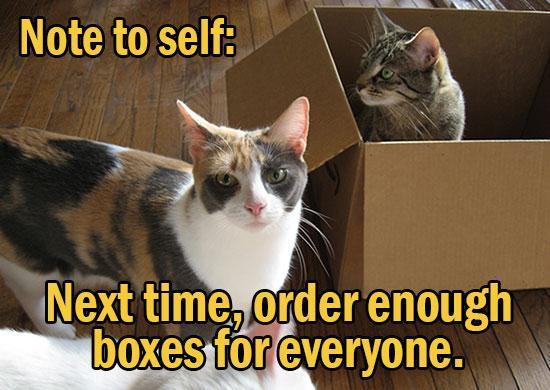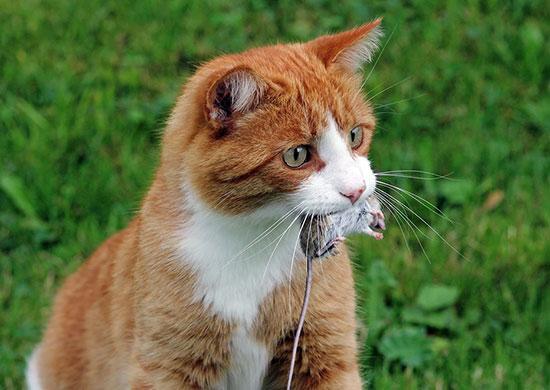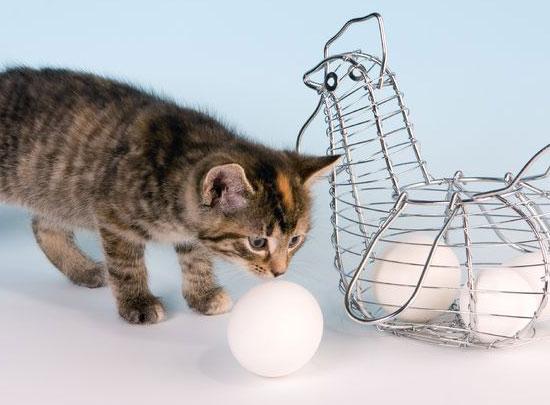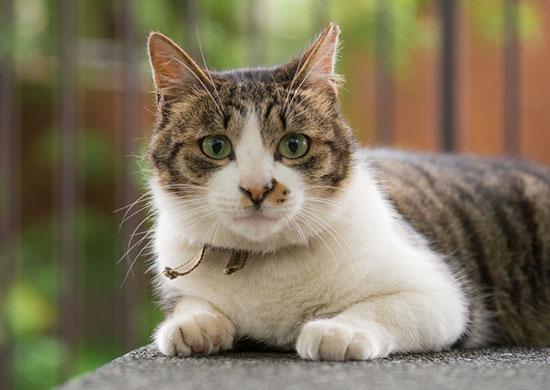This content is archived from the Feline Nutrition Foundation
 Diet plays a surprisingly large role in the health of your feline. Genetics play a role in disease, but what your cat eats, or doesn't eat, can influence overall health in major ways. Over the past seventy years or so, highly processed and carb-laden foods have become the norm for feeding cats. During this time, the incidence of many feline diseases such as diabetes, inflammatory bowel disease, kidney and urinary tract disease and dental disease have increased dramatically. We don't think this is a coincidence.
Diet plays a surprisingly large role in the health of your feline. Genetics play a role in disease, but what your cat eats, or doesn't eat, can influence overall health in major ways. Over the past seventy years or so, highly processed and carb-laden foods have become the norm for feeding cats. During this time, the incidence of many feline diseases such as diabetes, inflammatory bowel disease, kidney and urinary tract disease and dental disease have increased dramatically. We don't think this is a coincidence.
A bio-appropriate raw cat food diet can have a profound effect on the health of cats with these diseases. Proper cat nutrition can also influence whether a cat gets sick in the first place. In diabetes, low or no-carbohydrate raw food for cats can dramatically reduce or eliminate the need for insulin injections. Many cats with IBD that are put on raw diets show relief from symptoms, as do cats with urinary tract problems. Chewing on whole raw meats and raw meaty bones keeps teeth clean and gums healthy, reducing the chances of periodontal disease.
Think of a tiger. People naturally think of big cats eating raw meat. It's an image that comes easily to mind. Too often though, when people think of a housecat's meal, they think dry kibble. Cats are cats. We are doing our feline family members a disservice when we forget that they are highly-evolved predators, especially adapted to a diet of raw flesh. Forgetting that simple truth has allowed us to stray far from what our companion cats should be eating, with significant health consequences for our companion cats.
 Bio-Inappropriate: The Dangers of Dry Cat Food
Bio-Inappropriate: The Dangers of Dry Cat Food 
It is important to remove dry food from your cat's diet. This one change alone is a big step forward in improving cat nutrition and health. Dry food, be it premium, prescription or "natural," harms your cat's health. It consists mostly of starch and carbohydrates – it must be, as it can't be manufactured and extruded otherwise. The quality of the ingredients really doesn't matter – that's not the point. Simply that it is carb-laden and dry is enough to make it a terrible choice for cats. The carbs take the place of healthy meat-derived protein and fats that are vital for an obligate carnivore. All of these factors make dry foods detrimental to health.¹ Continued
Feline Diabetes: The Influence of Diet 
Feline diabetes mellitus is similar to human type II diabetes, also known as non-insulin dependent diabetes. In these patients, the pancreas is able to produce insulin, though it is not enough to adequately control blood sugar. This may be due to damage from inflammation of the pancreas, overwork and exhaustion of the pancreas due to chronically elevated blood sugar and/or if the cells of the body have become somewhat resistant to insulin. Whatever the cause or causes, the end result is the insulin produced by the pancreas is no longer enough to control blood sugar.¹ Continued
Feline Inflammatory Bowel Disease: Nature and Treatment 
The inflammatory bowel diseases are the most common cause of chronic vomiting and diarrhoea in cats, and refer to a group of diseases. The term Inflammatory Bowel Disease, or IBD, is applied to a group of poorly understood gut pathologies that are considered to be a consequence of uncontrolled intestinal inflammation in response to a combination of elusive factors that may involve the diet, the environment, the gut microflora and dysregulation of the immune system in susceptible cats. Continued
Feline Hyperthyroidism: What You Need to Know 
Hyperthyroidism, or thyrotoxicosis, is the most common endocrine disease in cats. When an animal or a person has hyperthyroidism it means that there is a high concentration of thyroid hormones in the blood. The opposite, low thyroid hormone levels, is called hypothyroidism. Hyperthyroidism occurs mostly in older cats, generally around 12 years old, although reports have shown a wide range between 4 and 23 years.¹ There is no predisposition related to sex or breed. Continued
A Diet for Your Cat's Urinary and Kidney Health 
There is a connection between what cats are fed and what diseases they might get. This is an idea that is becoming much more widely accepted. Diet plays a role in disease syndromes such as kidney disease, urinary problems such as stones and crystals, Feline Lower Urinary Tract Disease and gastrointestinal problems such as IBD. The kidneys regulate the water and salt balance in the body, maintaining hydration, electrolyte levels and regulating blood pressure. As proteins are metabolized by the body for energy, by-products are produced and circulated in the blood. It's the kidney's job to remove these toxic substances. Continued
Constipation: Real Help for Your Cat 
One of the immediate results when feeding kitty a raw cat food diet is less cat poop, and cat poop that smells less. While some owners welcome this change, others are concerned that their cats might be constipated. Feeding a raw cat food diet can closely resemble nutritionally what cats would eat if living wild, but, despite our best efforts, it is not a truly natural diet. That can only be replicated by feeding small whole prey. One of the biggest differences between raw cat food and a prey-based diet is fur. Continued
Phosphorus Can Be Key for Cat Kidneys
I have a cat with kidney disease and have heard that reducing phosphorus intake is important for cats with kidney problems. Is it safe to feed a cat with chronic kidney disease a raw food diet? Doesn't it have too much phosphorus? My cat hates the prescription diet and I am looking for an alternative for him. Dietary management is important for cats with kidney disease. There are three main aspects to this. Number one is water intake. Cats with chronic kidney disease are more likely to become dehydrated due to the reduced ability of the kidneys to conserve water by concentrating urine. Continued
Water, Water and Water Battles Crystals 
My 4 year old kitty, Roxy, had 5-6 crystallite stones in her bladder that were removed in January of this year. She has been on a raw cat food diet ever since, exclusively. I have noticed, though, that her water intake has gone to zero since starting the raw diet. I have been adding 6-8 teaspoons of water to her raw cat food every serving to make up for it. She has been tested four times since her surgery, x-rays and urine draw from the bladder with no crystals showing up.
So, we are one year out from Roxy having had calcium oxalate stones removed and so far no recurrences. Good job. Continued
Feline Cystitis and Bladder/Kidney Stones 
Cystitis and stones are extremely common in the cat and can be very painful and life-threatening. Cystitis can lead to inappropriate urination – urinating outside of the litter box – and stones can cause a fatal rupture of the bladder by blocking the outflow of urine.
Any cat that is repeatedly entering the litter box but not voiding any urine is in need of immediate medical attention. It is important to note, however, that "crystals" are not the same thing as stones. Continued
High Blood Pressure: Yes, Your Cat Can Get It, Too 
Hypertension is the medical term for high blood pressure, which is a common problem in older cats. It is commonly found as a complication of other underlying medical conditions, so-called secondary hypertension. However, primary or essential hypertension, i.e., hypertension that develops without any underlying medical disorder, may also be seen in cats.¹ In contrast to people, where essential hypertension is most common, secondary hypertension is more common in cats. Continued
Nutrition is Vital When Treating Feline Leukemia 
The feline leukemia virus, generally referred to as FeLV, is classified by virologists as a retrovirus. A retrovirus uses an enzyme called reverse transcriptase to insert copies of its own genetic material into the cells it has infected in order to produce a new copy of a whole virus. Infected cats can be found everywhere, but the prevalence varies depending on many factors: age, health, reproductive status, concurrent disease, environment and lifestyle. The worldwide prevalence is about 5% of free-roaming cats. Continued
Feline Pancreatitis: Signs of Trouble 
Pancreatitis can be a frustrating disease in cats. The cause often can't be definitively determined and the symptoms can be vague. Pancreatitis can range from low-grade with mild symptoms to severe, which can be fatal. Most often, treatment is supportive, alleviating symptoms and keeping the cat comfortable.
The pancreas is a lobulated gland located along a portion of the small intestine in mammals. The pancreas has two types of tissue, each synthesizing a different type of secretion. Continued
Another Furball? It Might Be Feline Asthma 
Has your cat been coughing? Watch the video below and you may recognize that sound. Many people assume that the cat is trying to cough up a hairball and don't realize that their cat could have asthma. Untreated, asthma can progress and even be fatal. But, like human asthmatics, cats can be treated and the disease can be managed.
It is estimated that about 1% of cats suffer from asthma.¹ Siamese, Burmese and other Oriental breeds show a greater incidence, but any breed can have asthma.² Continued
Open Wide: The Basics of Kitty Dentals 
Periodontal disease has become one of the most prevalent diseases in small animal practice since the advent of commercial pet foods. At the same time, it is one of the least diagnosed and least treated diseases of companion animals. Periodontal disease is the inflammation of the structures that give support to the teeth. This includes the soft tissue, as in the gums, and the hard tissue, the maxillary and mandibular bones. These bones have a series of holes, one for each tooth, lined up in a row. Continued
Cat Scratch Fever: How It Affects Cats
My vet suggested my cat have a test for Bartonella infection. I thought that cats didn't experience symptoms from infection with this bacterium, that it was only people that had to worry about becoming infected. Can my cat get sick from "cat scratch fever?"
Regarding cat health, there are certainly lots of conditions that are not directly food-related that worry dedicated cat owners. One of the diseases I am most frequently asked about is bartonellosis. Bartonella species are very small intracellular bacteria that can survive and replicate within erythrocytes.¹ Continued
Diet and Your Cat's Cancer Risk
Does what I feed my cat have anything to do with her chances of getting cancer? My friend's cat has cancer and now I want to do absolutely everything that I can to minimize my cat's chance of getting it.
What you feed your cat may very well play a role in his or her risk of the development of cancer.
Scientists and medical doctors have been aware of the link between chronic inflammation and cancer for over 100 years.¹ Continued
 Raw Cat Food Essentials and Fun Stuff, Too!
Raw Cat Food Essentials and Fun Stuff, Too! 
The Feline Nutrition Foundation is dedicated to educating people about the benefits of feeding their cats the right kind of diet. We want science-backed information to be freely available to everyone. That's a core part of our mission. We emphasize the freely part. Membership is free, all the information we offer is free and we don't have ads cluttering up the site. Everyone associated with our education and advocacy work is a volunteer. We are passionate about helping cats. But, passion doesn't pay the bills. Continued
 Chunks and Bones For Your Cat's Teeth
Chunks and Bones For Your Cat's Teeth 
Knowing that chewing on meat chunks and small pieces with bones, such as chicken wings, are "nature's toothbrush" for cats, I want my cat to eat these to help clean her teeth. But, she refuses to eat meat chunks no matter what I try. Someone told me this could be because her teeth hurt. She has some tartar on her teeth. Could this be why she won't eat chunks?
Domestic cats are obligates carnivores. They evolved to hunt, ingest and efficiently digest small prey. They have developed very specific taste and scent capabilities that prevent them from consuming anything that is not fresh. Continued
A Cat's Food Allergies and Intolerances Explained 
My cat almost always vomits after I feed her anything with beef in it. When I mentioned to a friend that I thought he was allergic to beef, she corrected me and said that vomiting was a sign of food intolerance, not a food allergy. Now I'm confused. What's the difference between the two? If they are two different things, what are the signs to look for in each case?
Food allergy is a specific type of reaction by the body to an allergen, usually a protein in the food. It is defined as "an adverse reaction to a food or food additive with a proven immunologic basis."¹ Continued
How Toxoplasmosis Affects Cats
My cat occasionally eats mice she catches outdoors, so I worry that she might be exposed to toxoplasmosis. I know about the dangers to humans from toxoplasmosis, but is it dangerous to my cat, too? Would I even be able to tell if she got it?
Wild and domestic felines are the only definitive hosts for the toxoplasmosis parasite. Both phases of toxoplasma gondii, sexual and asexual, occur in cats; that's the reason why felines are the main reservoir of the disease. The rest of the non-feline, warm-blooded animals are known as intermediate hosts. Continued
Avoiding Hepatic Lipidosis in Your Cat 
I'm transitioning my reluctant kitties to raw cat food and a few times they have refused to eat it. I always end up giving them something else since I have read all of the warnings about going without food for too long and getting hepatic lipidosis.
How dangerous is it them to go without eating? What should I look out for?
Hepatic lipidosis, also called fatty liver disease, may be the most common disease of the liver of the cat. It occurs when there is an excessive accumulation of fat inside the cells and tissues of the liver. Continued
How Raw Food for Cats Affects Blood Test Results
My cat used to be fed a dry kibble diet. I've been feeding her a raw cat food diet for the past six months and I'm very happy with the results. She is going in for her annual checkup soon. Will her new diet cause changes in her blood work?
Yes, there can be slight changes in some of the blood work values because of the switch to a high-protein, very low or non-carbohydrate diet. People who feed raw diets – and this applies to cats and dogs – sometimes find that their pet's BUN or blood creatinine are slightly elevated. Continued
Get Kitty Exercising to Trim Down 
Do cats need to exercise? My cat is overweight. Would exercising help him to lose weight like people? If so, what should I get him to do and for how long? I never think of cats doing anything for an extended period of time, just short bursts of activity, like running, chasing or climbing. Is it known how many calories a cat burns chasing a toy for ten minutes?
The short answer to the question is yes, cats do need exercise. We can conclude this because, while their digestive physiology may be unique, the cardiovascular physiology of cats appears to be similar to other mammals, such as humans. Continued
Salmonella: The Chicken or the Egg 
Are raw eggs safe to feed to your cat? You may be wondering after hearing about eggs being contaminated with salmonella. Eggs are a great food source for cats. Raw egg yolks are a good source of protein, folate, vitamin B12, omega-3 and omega-6 fatty acids. Eggs are also a good source of the antioxidant lutein. Egg whites are an excellent source of phosphorus-free protein for those cats that need a phosphorus-reduced diet. Egg whites should be served cooked, as raw egg white can interfere with biotin absorption.¹ Continued
Safe Handling Practices for Raw Meat 
One of the major concerns of people feeding a raw diet is safe food handling to protect the human family and our companion animals. Knowing the difference between spoilage and pathogenic bacteria as well as following temperature and time guidelines makes our decision to feed a raw diet easier. Much of the information provided in this article is directed at human safety – a standard also used by many people when feeding their companion animals. This information is from the Food Safety and Inspection Service of the USDA and other sites that rely on USDA and FDA guidelines. Continued
If You're Feeling Stressed, So Is Your Cat 
We live in challenging times and external stressors abound. Our work, the news and often just getting through the day all present a source of stress for people. It's known that owning a pet has beneficial effects on our health.¹ Pets help us slow down. We get so caught up in the business of our daily lives that we rarely take enough time to stop and take a break. Studies have shown that even a few minutes of petting your cat or dog can lower your blood pressure and release endorphins that put you in a better mood.² Continued
Choosing the Right Insulin for Your Diabetic Cat 
My cat was diagnosed with steroid induced-diabetes. For the past three years, he's been on Depo-Medrol® injections every three months or so for IBD. Could his diabetes be reversed? He always ate mostly raw cat food and Katz-N-Flocken® dry. I am now weaning him to Wysong Epigen® with no carbs. He was just diagnosed and started on NPH insulin. Should I insist on PZI?
First, I'd like to address the issue of treating inflammatory bowel disease with Depo-Medrol® injections. Depo-Medrol® is an injectable repository form of very potent corticosteroid. Continued
A Veterinarian's View on Raw Cat Food: Andrea Tasi, VMD 
My name is Andrea Tasi, and my whole life revolves around cats and cat care. I graduated from the University of Pennsylvania School of Veterinary Medicine in 1988 and was determined to go out into the world and help sick cats get better, and keep well cats well. I have been in feline-exclusive practice since 1991, first in Philadelphia and now in the Washington, D.C. metropolitan area. I have watched cats become the most popular pet in our country, and been part of the evolution of feline-specific veterinary medicine. Continued




